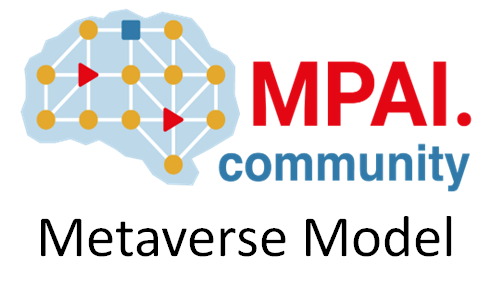MPAI is pleased to announce that, after a full year of efforts, it has been able to publish the MPAI Metaverse Model, the master plan of a project designed to facilitate the establishment of standards promoting Metaverse Interoperability. Watch
| YouTube video | Non-YouTube video |
The industry is showing a growing interest in the Metaverse that is expected to create new jobs, opportunities, and experiences with transformational impacts on virtually all sectors of human interaction.
Standards and Artificial Intelligence are widely recognised as two of the main drivers for the development of the Metaverse. MPAI – Moving Picture, Audio, and Data Coding by Artificial Intelligence – plays a role in both thanks to its status as an international, unaffiliated, non-profit organisation developing standards for AI-based data coding with clear Intellectual Property Rights licensing frameworks.
The MMM is a full-bodied document divided in 9 chapters.
- Introduction gives a high-level overview of the MMM and explains that the MMM is published for community comments where MPAI posts the MMM, anybody can send comments and contributions to the MPAI Secretariat, MPAI considers them, and publishes the MMM in final form on 25 January.
- Definitions gives a comprehensive set of Metaverse-related terms and definitions.
- Assumptions details 16 assumptions that the proposed Metaverse standardisation process will adopt. Some of them are:
- the steps of the standardisation process.
- the availability of Common Metaverse Specifications (CMS).
- the eventual development of Metaverse Profiles.
- a definition of Metaverse Instance and Interoperability.
- the layered structure of a Metaverse Instance.
- the fact that Metaverse Instances already exist.
- the definition of Metaverse User.
- Use Cases collects a large number of application domains that will benefit from the use of the Metaverse. They are analysed to derive Metaverse Functionalities, such as:
- Automotive,
- Education,
- Finance,
- Healthcare
- Retail.
- External Services collects some of the services that a Metaverse Instance may require either as a platform native or as an externally provided service and are analysed to derive Metaverse Functionalities.. Examples are:
- content creation
- marketplace
- crypto wallets.
- Functionalities is a major element of the MMM in its current form. It collects a large number of Functionalities that a Metaverse Instance may support depending on the Profile it adopts. It is organised in 9 areas, i.e.,
- Instance,
- Environment,
- Content Representation,
- Perception of the Universe by the Metaverse,
- Perception of the Metaverse by the Universe,
- User,
- Interaction,
- Information search
- Economy support.
- Each area is organised in subareas: e.g., Instance is subdivided into
- Management
- Organisation
- Features
- Storage
- Process Management
- Security.
- Each subarea provides the Functionalities relevant to that subarea, e.g., Process Management includes the following Functionalities:
- Smart Contract
- Smart Contract Monitoring
- Smart Contract Interoperability.
- Technologies has the challenging task of verifying how well technologies match the requirements of the Functionalities. Currently, the following Technologies are analysed:
- Sensory information – namely, Audio, Visual, Touch, Olfaction, Gustation, and Brain signals.
- Data processing – how can we cope with the end of Moore’s Law and with the challenging requirements for distributed processing.
- User Devices – how Devices can cope with challenging motion-to-photon requirements.
- Network – the prospects of networks providing services satisfying high-level requirements, e.g., latency and bit error rate.
- Energy – the prospects of energy storage for portable devices and of energy consumption caused by thousands of Metaverse Instances and potentially billions of Devices.
- Governance identifies and analyses two areas:
- technical governance of the Metaverse System if the industry decides that this level of governance is in the common interest.
- governance by public authorities operating at a national or regional level.
- Profiles provides an initial roadmap from the publication of the MMM to the development of Profiles through the development of
- Metaverse Architecture
- Functional Requirements of Data types
- Common Metaverse Specification Table of Contents
- mapping of MPAI standard Technologies into the CMS
- inclusion of all required Technologies
- drafting of the mission of the Governance of the Metaverse System.
The MMM is a large integrated document. Comment on the MMM and join MPAI to make it happen!


